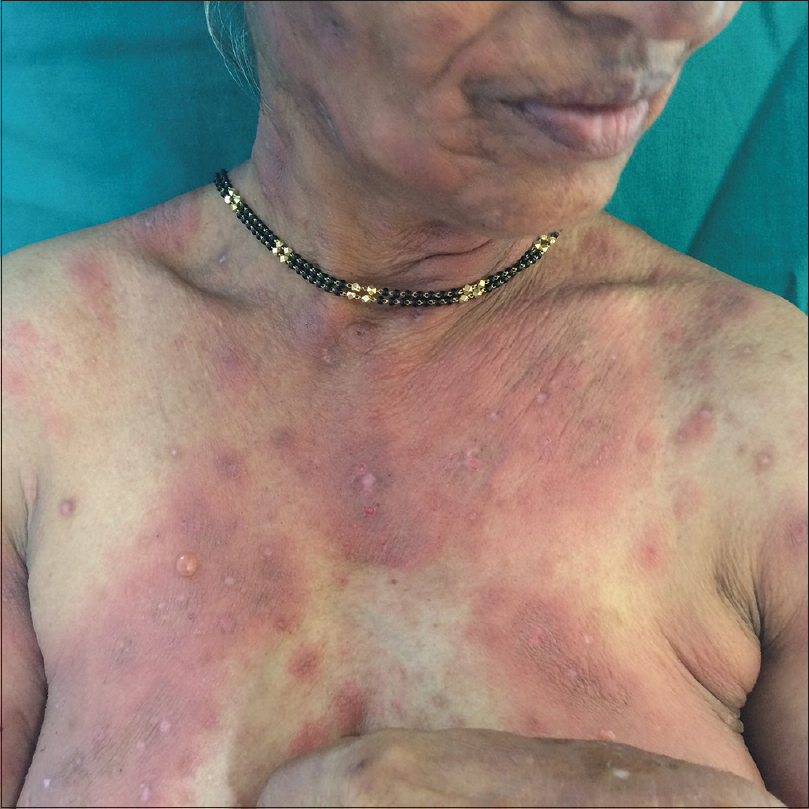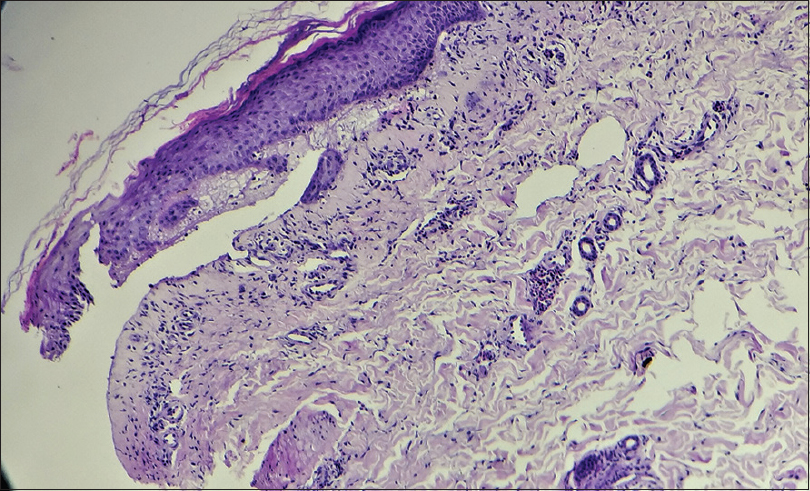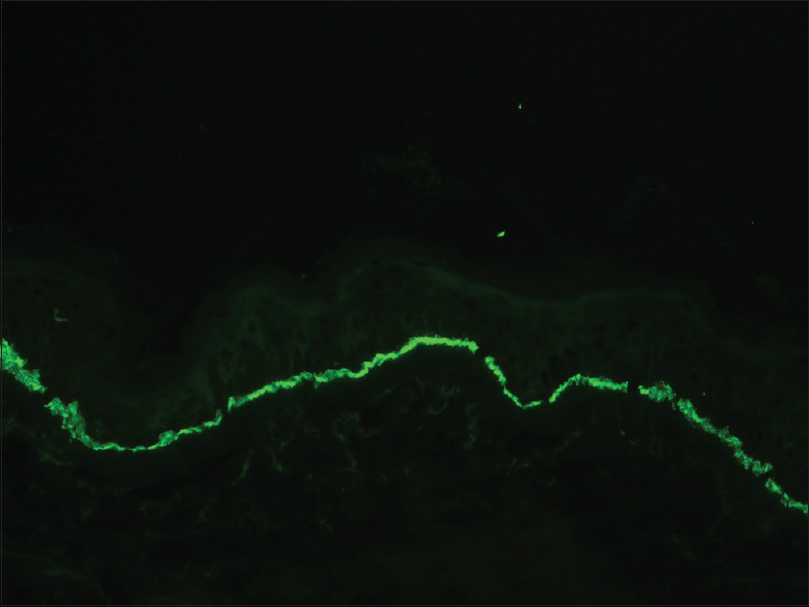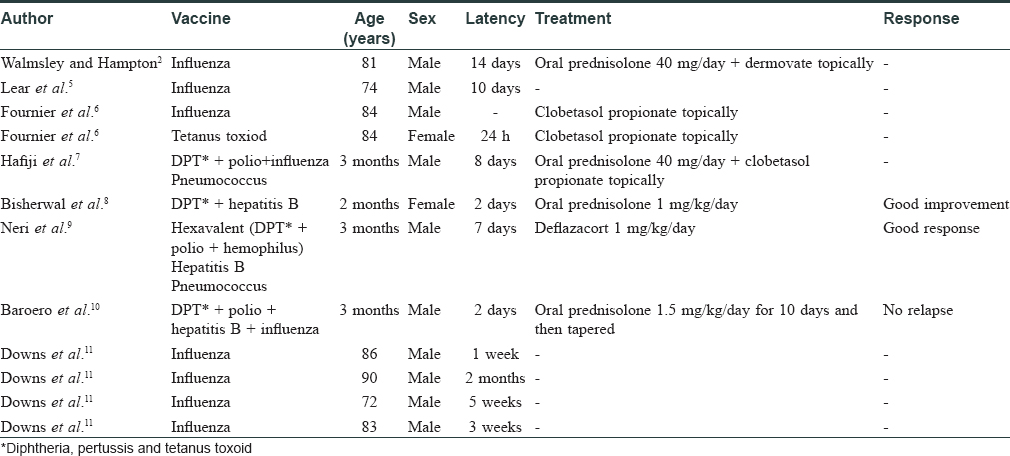Translate this page into:
Bullous pemphigoid triggered by rabies vaccine
2 Department of Pathology, Kasturba Medical College, Manipal Academy of Higher Education, Manipal, Karnataka, India
Correspondence Address:
Sudhir U. K. Nayak
Associate Professor, Department of Dermatology, Venereology and Leprosy, Kasturba Medical College, Manipal Academy of Higher Education, Manipal, Karnataka
India
| How to cite this article: Jindal A, Nayak SU, Shenoi SD, Rao R, Monappa V. Bullous pemphigoid triggered by rabies vaccine. Indian J Dermatol Venereol Leprol 2020;86:66-68 |
Sir,
Bullous pemphigoid (BP) is an autoimmune blistering disease characterized by autoantibodies toward basement membrane zone antigens BP180 and BP230.[1] There are many known trigger factors for this immunobullous disorder such as ultraviolet (UV) radiation, drugs, trauma and burns. Diphtheria, pertussis and polio vaccines have also been documented to trigger the onset of bullous pemphigoid.[2] We report a case of bullous pemphigoid triggered by rabies vaccine.
A 60-year-old female presented with sudden onset of itchy fluid-filled lesions of 20 days duration. The patient gave a history of dog bite for which 0.1 mL of inactivated rabies virus vaccine was injected intramuscularly on 0, 3 and 7 days. Six days after the dog bite, the patient started developing vesicles and bullae on the skin. Blisters were first noticed near the site of administration of rabies vaccine and then later disseminated to involve trunk and extremities over the next 3 days. Examination showed multiple urticated and erythematous plaques and tense bullae on erythematous base measuring 1–3 cm in diameter on trunk, forearms and thighs [Figure - 1]. Bulla spread sign was positive. Tzanck test performed from a fresh bulla showed eosinophils. Histopathology from an urticarial plaque showed subepidermal blister with occasional lymphocytes and eosinophils with dermal perivascular infiltrate of eosinophils and lymphocytes, suggestive of cell poor variant of bullous pemphigoid [Figure - 2]. Direct immunofluorescence showed basement membrane zone staining with complement 3 [Figure - 3]. Enzyme-linked immunosorbent assay for antibodies against BP180 was positive with a titer of 130 RU/mL. Taking into consideration all these findings, diagnosis of bullous pemphigoid was established and the patient was started on prednisolone 1 mg/kg along with nicotinamide 250 mg twice a day. She responded very well to the treatment and new lesions stopped appearing after 7 days.
 |
| Figure 1: Multiple tense bullae and erosions present on an erythematous base on the trunk |
 |
| Figure 2: Subepidermal cleft with minimal inflammatory infiltrate and dermis showing perivascular eosinophilic and lymphocytic infiltration (H and E, ×100) |
 |
| Figure 3: Direct immunofluorescence of perilesional skin showing linear basement zone staining with complement 3 (FITC, ×200) |
When the fourth dose of inactivated rabies vaccine was administered on day 28 of the rabies vaccine schedule, the patient started developing fresh blisters. The dose of prednisolone was increased by 20 mg after 3 days of which new blisters stopped appearing. The temporal association between administration of vaccine and appearance of bullous lesions was a pointer that rabies vaccine might be the trigger while reemergence of bullae following readministration of vaccine confirmed the diagnosis in this case.
BP is an autoimmune blistering disorder, with formation of autoantibodies against hemidesmosomal plaque, that is, non-collagenous zone (NC16A) of transmembrane protein BP180.[1] Various trigger factors have been reported in literature, including UV radiation, drugs, trauma, radiotherapy and burns.[3] When a genetically predisposed individual is exposed to a trigger, it leads to revelation of BP180 antigen generating an immune response mediated through B lymphocytes leading to production of autoantibodies to the same. These antibodies lead to activation of complement pathway causing the release of protease resulting in subepidermal cleavage.[4] Various vaccines have been implicated to trigger bullous pemphigoid, including diphtheria, pertussis, polio, haemophilus influenza B, pneumococcus and swine flu vaccine [Table - 1]. The time period of onset of lesions after the administration of vaccine varied from less than 1 day to 1 month.[2],[5] The mechanism for induction of bullous pemphigoid in response to vaccine is not very well understood. It has been proposed that bullous pemphigoid might be triggered in some genetically predisposed individuals after exposure to live attenuated vaccine which heightens the immune response. The main mechanism through which vaccines especially inactivated vaccines provide immunity is humoral pathway, that is, by stimulation of B lymphocytes leading to production of antibodies. Rabies vaccine has also been reported to trigger pemphigus.[12] As both are antibody mediated, this heightened immune response may be responsible for precipitating bullous pemphigoid also.

Our patient presented to us within 6 days of administration of first dose of rabies vaccine when she started developing blisters. The onset of lesions was near the site of vaccination which then involved trunk and limbs. Readministration of rabies vaccine leading to reemergence of blisters after initial control with oral steroids was a confirmation to the association of rabies vaccine and bullous pemphigoid.
This is perhaps the first case report of rabies vaccine leading to bullous pemphigoid.
Declaration of patient consent
The authors certify that they have obtained all appropriate patient consent forms. In the form, the patient has given her consent for her images and other clinical information to be reported in the journal. The patient understands that name and initials will not be published and due efforts will be made to conceal identity, but anonymity cannot be guaranteed.
Financial support and sponsorship
Nil.
Conflicts of interest
There are no conflicts of interest.
| 1. |
Bernard P, Antonicelli F. Bullous pemphigoid: A review of its diagnosis, associations and treatment. Am J Clin Dermatol 2017;18:513-28.
[Google Scholar]
|
| 2. |
Walmsley N, Hampton P. Bullous pemphigoid triggered by swine flu vaccination: Case report and review of vaccine triggered pemphigoid. J Dermatol Case Rep 2011;5:74-6.
[Google Scholar]
|
| 3. |
Schmidt E, Zillikens D. The diagnosis and treatment of autoimmune blistering skin diseases. Dtsch Arztebl Int 2011;108:399-405, I-III.
[Google Scholar]
|
| 4. |
Iwata H, Kitajima Y. Bullous pemphigoid: Role of complement and mechanisms for blister formation within the lamina lucida. Exp Dermatol 2013;22:381-5.
[Google Scholar]
|
| 5. |
Lear JT, Tan BB, English JS. Bullous pemphigoid following influenza vaccination. Clin Exp Dermatol 1996;21:392.
[Google Scholar]
|
| 6. |
Fournier B, Descamps V, Bouscarat F, Crickx B, Belaich S. Bullous pemphigoid induced by vaccination. Br J Dermatol 1996;135:153-4.
[Google Scholar]
|
| 7. |
Hafiji J, Bhogal B, Rytina E, Burrows NP. Bullous pemphigoid in infancy developing after the first vaccination. Clin Exp Dermatol 2010;35:940-1.
[Google Scholar]
|
| 8. |
Bisherwal K, Pandhi D, Singal A, Sharma S. Infantile bullous pemphigoid following vaccination. Indian Pediatr 2016;53:425-6.
[Google Scholar]
|
| 9. |
Neri I, Greco A, Bassi A, Orgaz-Molina J, Balestri R, Oranges T, et al. Bullous pemphigoid in infant post vaccination: Myth or reality? Int J Immunopathol Pharmacol 2016;29:295-9.
[Google Scholar]
|
| 10. |
Baroero L, Coppo P, Bertolino L, Maccario S, Savino F. Three case reports of post immunization and post viral bullous pemphigoid: Looking for the right trigger. BMC Pediatr 2017;17:60.
[Google Scholar]
|
| 11. |
Downs AM, Lear JT, Bower CP, Kennedy CT. Does influenza vaccination induce bullous pemphigoid? A report of four cases. Br J Dermatol 1998;138:363.
[Google Scholar]
|
| 12. |
Yalçin B, Alli N. Pemphigus vulgaris following antirabies vaccination. J Dermatol 2007;34:734-5.
[Google Scholar]
|
Fulltext Views
7,270
PDF downloads
2,919





